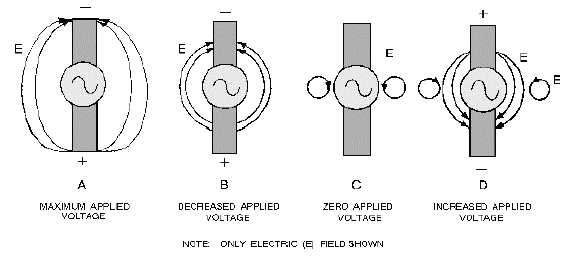2-5
Figure 2-3.—Radiation from an antenna.
As the voltage approaches zero (view B), some of the lines collapse back into the antenna. At the
same time, the ends of other lines begin to come together to form a complete loop. Notice the direction of
these lines of force next to the antenna in view C. At this point the voltage on the antenna is zero. As the
charge starts to build up in the opposite direction (view D), electric lines of force again begin at the
positive end of the antenna and stretch to the negative end of the antenna. These lines of force, being in
the same direction as the sides of the closed loops next to the antenna, repel the closed loops and force
them out into space at the speed of light. As these loops travel through space, they generate a magnetic
field in phase with them.
Since each successive E field is generated with a polarity that is opposite the preceding E field (that
is, the lines of force are opposite), an oscillating electric field is produced along the path of travel. When
an electric field oscillates, a magnetic field having an intensity that varies directly with that of the E field
is produced. The variations in magnetic field intensity, in turn, produce another E field. Thus, the two
varying fields sustain each other, resulting in electromagnetic wave propagation.
During this radiation process, the E and H fields are in phase in time but physically displaced 90
degrees in space. Thus, the varying magnetic field produces a varying electric field; and the varying
electric field, in turn, sustains the varying magnetic field. Each field supports the other, and neither can be
propagated by itself. Figure 2-4 shows a comparison between the induction field and the radiation field.

